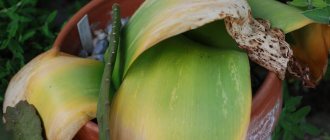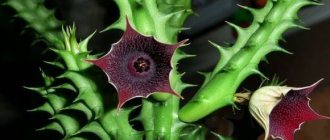Description
Mass breeding of tulips began 500 years ago in Holland. Today there are many types and varieties of these flowers, and interest in growing them has not waned. The plant reaches a height of 10 cm. The root system consists of a bulb and adventitious roots, which die off annually. Gradually, a replacement bulb forms in place of the old one.
Related article:
Planting tulips in autumn at the most appropriate time
The stem is erect, cylindrical in shape. The leaves are bluish-green, lanceolate, arranged alternately on the stem in 2 or 5 pieces. The plant traditionally produces one bud, but there are also multi-flowered varieties. The flowers consist of 6 petals in red, violet, white, purple or yellow. There are varieties with incredible combinations of shades.
The shape of the buds is varied: cup-shaped, star-shaped, oval, fringed, peony-shaped. The size depends on the variety, usually from 3 to 10 cm. After flowering, a box with triangular brown seeds is formed.
Features of cultivation
In order to successfully grow such unusually beautiful flowers, you should definitely learn how to properly care for them. At the same time, the rules for caring for tulips are not very complicated, and even a grower with very little experience can cope with their cultivation.
Tulips: growing, care, reproduction
Basic Rules
- During intensive flower growth, fertilizer must be added to the soil 3 times.
- You can understand what kind of fertilizer a plant lacks by its appearance. So, if the leaves have become less wide and are not able to maintain a vertical position, then the tulip needs nitrogen-containing fertilizer. The blue color that appears along the edges of the foliage means that the plants lack potassium and phosphorus.
- Diseased tulips must be pulled out of the soil along with the bulbs. To disinfect the soil, you need to pour a freshly boiled solution of potassium manganese into the formed hole.
- The soil in the immediate vicinity of the flower should be treated carefully. The fact is that you can very easily damage the leaf plates or roots of the plant, and then the bulb may lose nutrition.
- If you want to enjoy the appearance of a fairly large flower next year, and also to prevent the bulb from splitting into several small ones, you must pick the wilted flower before the fruit appears.
- The dug up bulbs are dried in a shaded place, as they react extremely negatively to direct rays of the sun.
- Adding fresh manure to the soil can lead to rotting of the bulbs, as well as the appearance of fungal diseases.
- If it is cold in winter and there is little snow, then it is necessary to mulch the soil surface using peat, sawdust, humus or straw.
- If you cut a flower from a plant, you must leave at least 2 leaves. In this case, the bulb will be able to receive normal nutrition for full development.
- When choosing a plot of soil for planting, you should plant tulips in a place where they have not been grown for at least 3 years.
Choosing a landing site
To grow tulips in open ground, choose a sunny area with diffused lighting. Flowers can be planted under trees or shrubs if the leaves appear late and do not shade the tulips during budding.
Bulbs are grown in light, well-drained, fertile soils. Flowers love loams or sandstones. Plants prefer neutral or alkaline soil. Before planting, you cannot apply fresh organic fertilizers: tulips do not tolerate them.
Interesting! How to beautifully plant tulips on the site
The area for planting flowers should be level and well heated. They do not like excess water, drafts and strong winds. When choosing a site, it is important that no bulbous plants have grown on it for the last 3 years, as diseases and pests accumulate, increasing the risk of infection of new plantings.
Related article:
Planting tulips in autumn
Plant care: a short excerpt
Tulips are planted in the fall - until the beginning of October. Dig out the bulbs when approximately 2/3 of the green part of the plant turns yellow.
The bulbs are stored in specialized open containers (boxes), they are placed there in one layer, and the room is provided with a good level of ventilation and an average room temperature is achieved (about 20 degrees). Over time, the temperature is reduced by 2-3 degrees.
Pronounced sunlight or slight shading is well suited for growing tulips.
Tulips grow well both in bright light and in shade
Choose a neutral soil for tulips, and you won’t go wrong. In extreme cases, slightly alkaline will do. You will need to provide a good drainage system, and you also need to fertilize the plants in advance with wood ash and humus.
Tulips need good watering - you don’t need to skimp on water, and you don’t need to let the soil dry out either. This is most required during the period when the buds are set and the first flowers appear. As for fertilizers, you can give preference to both mineral and organic products. The first feeding is done immediately after the first shoots appear, and the next one is done when the buds are set. After the plants have flowered, you can apply the third and final fertilizing.
Important! If you decide to start propagating tulips, then it is worth knowing that they can be propagated by both seed and vegetative methods (daughter bulbs are used).
Such flowers are propagated by seeds and daughter bulbs.
Significant damage to the tulip is caused by cutworms, onion mites, slugs, rodents and mole crickets. Also, many plants may be poorly resistant to various types of rot, some viral plant diseases and tobacco necrosis.
Time to board
Agricultural technology for tulips in open ground involves planting in the autumn. Rooting takes up to 1 month. If flowers are planted too late, they will produce small buds and bulbs. The optimal period is mid-September, when the soil at a depth of 10-12 cm reaches a temperature of +10 degrees.
You can plant bulbous plants in the spring, but you can’t count on lush flowering. The bed is prepared when the snow melts. For different regions, this time ranges from mid-March to April.
A little history about tulips
Since ancient times, the tulip has always been very popular among different peoples. The very first information about him is associated with Persia. Many poets praised this delightful flower in their works. One of them, Hafiz, wrote that even a rose cannot compare with the virgin beauty of a tulip.
When the tulips arrived in Turkey, active breeding of new varieties began there. By the 14th century their number reached about 300.
In Turkey, this magnificent flower enjoyed even greater sympathy and love. In the fairy-tale gardens of the sultans themselves, great celebrations were held in honor of the tulip.
Planting tulips
For spring planting, furrows are prepared at a distance of 25-30 cm from each other. For daughter specimens, a distance of 10-15 cm is sufficient. Compost (2 buckets per 1 sq. m.) and wood ash (200 g per 1 sq. m.) are added to the soil. To improve drainage, add a 3-centimeter layer of river sand. The bulbs are deepened by 10-12 cm, the children - by 5-7 cm. The planting material is sprinkled with earth and leveled with a rake.
Related article:
Secrets of experienced gardeners: 6 rules for planting tulips in autumn
For autumn planting, the bulbs are soaked in a solution of potassium permanganate for 0.5-1 hour. The principle of preparing beds is the same as the spring method, but the depth increases. In light soils, planting material is rooted at a depth equal to 3 bulb diameters, in heavy soils - two. The maximum depth is 20 cm. The material is placed horizontally with the bottom down. The planting area is mulched with peat or sawdust.
Planting in containers is carried out in a similar way. Substrate and drainage are poured into flower pots, and planting material is deepened into them. Containers are stored in a cool, shaded area. They are brought out into the light and into warmth after the sprouts appear.
For information: When to plant tulips
Preparing bulbs for spring planting
A key role in planting tulips in the spring is played by the correct preparation of planting material for planting. That is, the bulbs must first be “strengthened” before transplanting into open ground. It happens like this:
- Wrap the bulbs in newsprint and make holes there. Place the bag in the vegetable section of the refrigerator. A temperature of +4-+6 degrees will be ideal for them. In such conditions, storage of planting material can occur for a long time, from autumn, for example. You need to periodically inspect the bulbs and remove damaged specimens.
- After hardening, the raw materials must be treated against possible diseases and pest damage. To do this, place the bulbs in a weak solution of potassium permanganate for 30 minutes, then remove and let dry. If there are cut areas on the material, sprinkle them with crushed activated carbon.
- Afterwards, carefully inspect the planting material for the integrity of the top layer, as well as for the absence of signs of infection with fungal diseases. “Defective” raw materials should be thrown away - only stunted and weakly flowering plants will grow from them.
- In March-April, take a low box, pour soil into it and lay the bulbs compactly on the surface in one layer. Sprinkle soil on top, about 5 cm above the bulbs, and water. Such planting will only speed up subsequent flowering.
- As soon as the shoots appear, the bulbs can be transplanted into a flower bed.
The preparation of the bulb for planting ends here. Next, you need to start preparing the future flower bed, after which you can begin transplanting the bulbs into the ground.
Further care
Knowing how to plant and grow tulips correctly, you can achieve lush flowering. Caring for plants involves watering, loosening the soil, and timely fertilizing. After flowering, it is important to allow the bulb to ripen, creating optimal conditions, and preserve the planting material.
Related article:
How to beautifully plant tulips on a plot + photo
Humidity and watering
Tulips cannot be called drought-resistant, but they do not tolerate waterlogging. During the development of the root system, the crop requires stable soil moisture and regular watering.
In the spring, before the buds appear, the plant is watered only in dry weather. With the appearance of flowers, the classic frequency of watering is once a week (10-40 liters per 1 sq. m), but it is better to focus on the condition of the soil and the depth of the root system. After flowering, stop watering after 2 weeks so that there is enough moisture for the formation of a new bulb.
Watering is done between the rows, trying to prevent water from getting on the leaves. Do not moisten the soil by pouring liquid under the root. The water must not be cold, but at room temperature.
Related article:
Preparing tulips for planting
Top dressing
The main feature of growing tulips is that it is impossible to get lush blooms without regular feeding. The plants are fertilized for the first time in early spring. You can use dry nutrient mixtures: 2 parts nitrogen and phosphorus and 1 part potassium, scattering them between plantings at the rate of 50 g per square meter. m followed by watering.
The second feeding is done during the budding period. The amount of nitrogen is reduced to 1 part, and the volume of phosphorus and potassium is increased to 2 parts. For the third time, the crop is fed after flowering only with potassium-phosphorus fertilizers. As the second time, take 30-35 g of the mixture per 1 square meter. m.
Along with fertilizing, weeding and loosening are carried out regularly. Weeds deplete the soil, taking away its beneficial substances. Loosening retains moisture and prevents weed growth.
Related article:
When to plant tulips in 2021
Cutting
Tulips are prepared for bouquets in the morning, when the buds are tightly closed. The stem is cut at an angle. Plants are kept cool. If the flowers are for sale, the cuts are renewed by dipping the stem in cool water.
When the bud begins to fade, it is carefully removed by hand. It is important to prevent the formation of the seed box so that the plant can form a full-fledged replacement bulb. Fruiting contributes to the shredding of the variety, so experienced gardeners try to remove faded buds in a timely manner. This process is called decapitation. It is carried out a few days after the flower opens.
Reproduction
Flowers are propagated by seeds and vegetatively. The first option is used by breeders: daughter sprouts do not retain the maternal varietal characteristics. Planting material is deepened into the soil or substrate in greenhouses and grown in one place for several years. Tulips grown from seeds bloom only for 5-6 years.
Related article:
Everything you need to know about properly transplanting tulips
For home propagation, the preferred method of propagation is by daughter bulbs. They develop when the maternal one dies. The replacement specimen has several children, which in a few years will be able to form flower stalks themselves.
To prevent flowers from degenerating, only planting material with a circumference of 12 cm or more is used for propagation. Such specimens retain varietal characteristics. Finer material can be used for home forcing. The children are grown to the required size and only then planted in the flowerbed.
Types and varieties of tulips
There is a register of varieties in which a huge variety of tulip varieties (about 10 thousand) are classified into 4 groups:
- Early flowering: Golden Olga, early terry, Electra, Schunord, etc.
- Medium flowering: Triumph, Crater, Golden Eddie, Vivex, etc.
- Late flowering: Georgette, Gisella, Bacchus, Triumphant, Maya, Exotic, etc.
- Species, botanical: Lady Rose, Zombie, Plaisir, Crown, Diamond, etc.
The most interesting achievement of the breeders was the black tulip. Haarlem tulips of dark purple shades were bred back in the 17th century. It took 400 thousand dollars and 300 years to achieve completely black color. In 1986, the director of the Floristic Institute of the Netherlands announced that a new rare black specimen had been bred.
Today everyone can grow tulips on their own plot. You just need to follow the recommendations of experienced flower growers, and the result will please you.
Digging and storing bulbs
To obtain luxurious flowering, annual digging of the bulbs and storage outside the ground is required until the next planting. The procedure begins when the plant’s leaves turn yellow. The stem becomes soft and the scales acquire a light brown tint.
Digging up too early will complicate storage and the plants will bloom worse. Traditional dates are late June – early July.
The bulbs are dug out carefully, with a supply of soil, to prevent damage. Select healthy whole specimens, not damaged by diseases and pests, with a circumference of 12 cm or more.
Related article:
Preparing tulips for planting
The planting material is kept under running water, then disinfected in a solution of karbofos or immersed in water at a temperature of 50 degrees for 10 minutes. Then they are laid out in a dry, ventilated room at a temperature of 25-30 degrees to dry for 4-5 days.
The bulbs are cleaned of husks, soil, old roots, and sorted by size. Planting material is placed in boxes in one layer. Containers are placed in a barn or in a cool room. There is no need to cover the boxes: ethylene released from adult specimens kills children. Preservation requires a temperature of 20 degrees, good ventilation and diffused light. So the material is left until autumn planting. Immediately before rooting into the ground, the temperature is reduced to 16 degrees.
Related article:
Fill the garden with beauty: 7 most beautiful varieties of tulips
Classification of tulips by flowering time
There is an official classification of tulips into 4 groups depending on the time of flowering - early-blooming, mid-blooming, late-blooming and a separate group - botanical and species. Each group is divided within itself into several more classes.
Early flowering
They bloom mainly at the end of April and are divided into simple and double, which indicates the structural features of the inflorescence:
- in simple ones, the diameter of the inflorescence varies from 25 to 40 cm, the most popular shape is a glass, among the famous varieties are Golden Harvest, Golden Olga, golden in color;
- Terry varieties are colored yellow or red, bloom for a long time, the most common varieties are Schoonord and Electra.
Medium flowering
They bloom in the average period from mid-April to mid-May, there are 2 classes - Triumph, Darwin hybrids, each of which has its own characteristics:
- Triumph - spectacular appearance of glass-shaped peduncles up to 70 cm long, a variety of various shades from white to purple, the most commonly planted varieties are Snowstar, Crater;
- Darwin hybrids grow up to 80 cm, the diameter of the inflorescences is more than 10 cm, among the advantages of the plants are frost resistance, strong immunity to the variegation virus, among popular varieties are Vivex, Apeldoorn.
Triumph
Late bloomers
The most extensive group, blooming from the second half of May, includes 7 classes - Simple late, Terry late, Fringed, Lily, Green, Rembrandt, Parrot.
Each class deserves separate consideration.
- Simple late ones - stretch up to 75 cm. The structure of the inflorescence is goblet-shaped with a square base, the shades are varied - from light to black, there are multi-colored tulips. The varieties Dillenburg and Bacchus are often planted.
- Terry late - often called peony-like due to the similarity with this flower in the double inflorescence. The height of the plants is average, the shades vary, the favorite varieties among summer residents are Eros and Nice.
- Fringed - they are characterized by petals with needles along the edges, reminiscent of a fringe. Plant height and color differ among varieties. These flowers are often grown for cut flowers; famous varieties include Flamenco and Liska.
- Liliaceae - the name speaks for itself, flower buds with petals turned outward are very similar to lilies. Inflorescences may lose shape in heavy rain. The most popular varieties are Jacqueline and West Point.
- Greens are a relatively new class. The flowers are always two-colored - a green center and petals of various shades - white, pink, red, the buds are cup-shaped. Gardeners' favorite varieties are Golden Artist, Spring Green.
- Rembrandt is a small class whose distinctive feature is the spots on the buds. The shape of the inflorescence is a glass. A popular variety is Absalon.
- Parrots are flowers of extraordinary appearance. You can notice a clear resemblance to the plumage of a parrot in the form of openwork petals, which are painted in a variety of shades. There are many multi-colored tulips, one of the frequently planted varieties is Fleming Perrott.
Rembrandt
Botanical and species
This group includes a variety of hybrids that bloom very early, belong to wild species, and when flowering, tulips acquire bright shades.
The most common classes:
- Kaufman tulips are used to decorate alpine hills due to their low height, they have good immunity against diseases and pests, a close variety is Corona, the inflorescence of which is similar to the crown;
- Foster's tulips - the flowers are larger than the representatives of the previous group, the shape of the inflorescences can be goblet-shaped or cup-shaped, the main colors of the petals are red and pink, the flowers are highly resistant to the variegation virus;
- Greig's tulips - this includes not only Greig's tulips, but also their hybrids, their height is small, but the inflorescences are large, the speckled leaves are interesting, the color of the slightly bent petals is predominantly red and orange.
Kaufman Tulip
Digging up the bulbs after flowering
What to do with flowers after blooming? First of all, the flower growers should be removed so that seeds do not begin to form.
Green leaves can be left; the plant will receive nutrients from them. But, if the foliage turns yellow, it would be right to start digging up tulips. It is impossible to indicate a specific time frame for the work - it depends on the area, plant variety, and weather conditions.
Choosing the right time can only be done based on the state of the plant. If flowers are grown on an industrial scale, the bulbs are dug up after flowering. However, next year they may be weakened.
You should not wait until the above-ground part of the plant completely dies off, since the bulb can become infected with some kind of infection and begin to rot. It should be dug up before the kids have gained strength. The optimal time for work is June, July.











